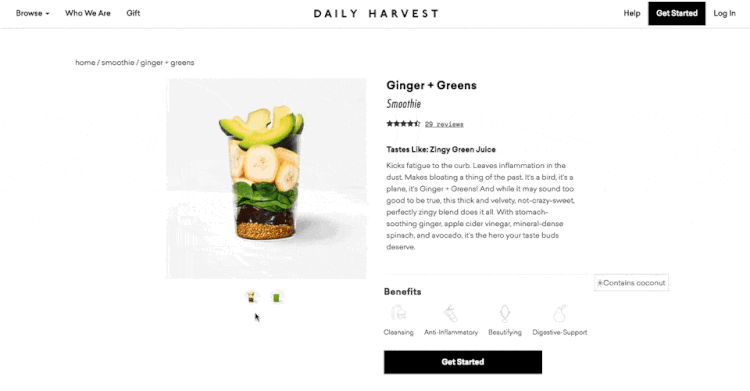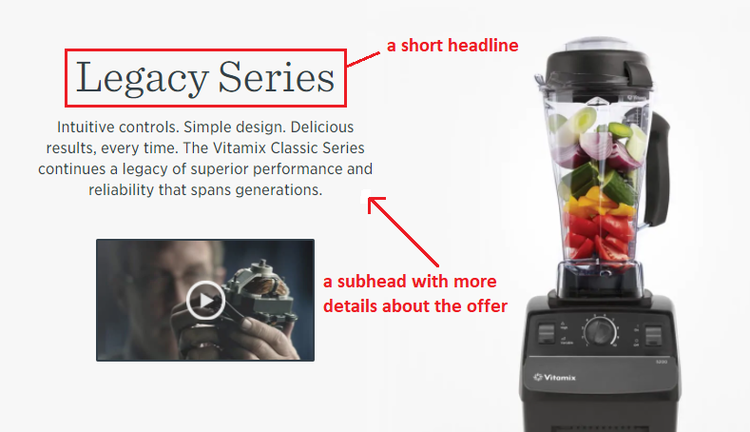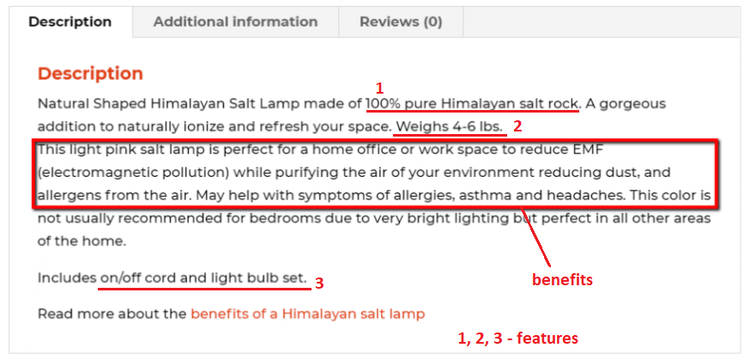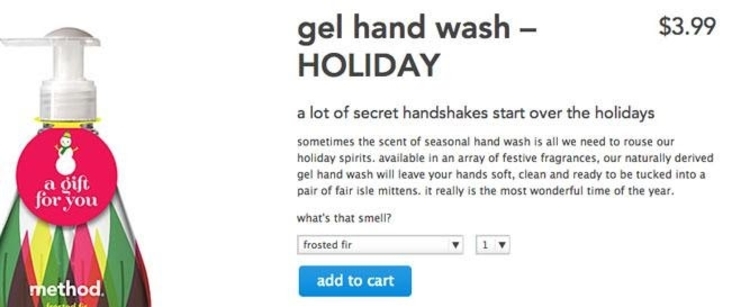Here’s something we can all agree on — It’s not that difficult to set up an online store today, and every other person wants to sell something.
And that is no wonder considering the following:
- According to a report from BigCommerce, 80% of Americans shop online at least once a month, while 5% do online shopping daily.
- In June 2021, e-commerce traffic reached a record 22 billion monthly visits.
Whether big or small, every business wants to find a way to tap into that sum. The problem is that the competition is enormous, and it can be a monumental challenge to convince people to buy from you rather than someone else out there.
So, what can help your online store page grab more user attention and motivate visitors to choose your product? Are there any content tricks you could implement to win the battle for customers?
In this article, we’ll talk about some copywriting tactics that could boost your online store page engagement and skyrocket its conversion.

What to do before writing content?
Before you actually start writing the copy, you need to determine a few important details:
- Define your target audience. No successful business has ever started a marketing campaign without understanding their buyer persona inside out. Ensure you know all the characteristics of your potential customers: age, gender, interests, motivations, and frustrations behind their buying behavior, features and benefits that would interest them in your product, etc. All of this information will help you know what to write on your store’s product and landing pages to increase your number of sales.
- Do keyword research. For your page to sell better, you need to optimize it for search engines so that your target audience can quickly find it. SEO begins with keywords, so focus on those relevant to your offer and matching your target customers’ search intent. You’ll include them in a page’s title and description, headlines product description, and image tags.
Elements to include to your online store page

When writing content for a product page it is important to pay attention to the content’s structure. It needs to include definite elements to grab and hold visitors’ interest, keep them engaged, and motivate them to click on the “Add to cart” button.
Your online store page content should have:
- A catchy headline, relevant to the information a person will find on the page.
- A compelling picture or even a few high-quality images of your product.
- An engaging product description where you’ll anticipate a buyer’s pain points and turn the features of your product into benefits.
- Related visual content if applicable: video descriptions or instructions, GIFs, graphs, tables, etc.
- Trust signals to make visitors feel secure and demonstrate that your business is worth their trust (social proof, customer reviews, guarantees, and so on).
- A call to action to reassure users they need your offer and encourage them to buy.
- Your contacts for visitors to see your business is real and that they can write to you for all the questions they might have on a product.
7 Copywriting tricks to consider for selling more
Finally, it’s time for writing practice. Here go your top seven copywriting tricks to boost an online store page’s conversion:
1. Craft a headline and a subhead
Apart from a quality photo demonstrating all the key benefits of your product to customers, they’ll pay attention to a headline and a subhead of your online store page. Not only do these two elements tell visitors what they’ll find there, but they should also engage them to learn more.
That’s why it is important to pay attention to how you write headlines and subheads on your product pages:
- Make a headline short yet compelling enough to encourage a visitor to keep on reading.
- Limit it to 10 words, consider the 4 Cs copywriting formula: It should be concise, clear, compelling, and credible.
- Provide more details about the offer in a subhead, which will appear just below the headline: It needs to be descriptive, informative, and punchy to persuade visitors to learn more. Feel free to use neuro-copywriting techniques here: active verbs, beneficial adjectives, power words, questions, quotes, numbers, and more.

2. Focus on benefits, not features
When writing a product description on your page, say no to listing the bare facts about its features. Please think of how they anticipate your customer’s pain points and how he or she can benefit from using your product.
Write about how your product can improve a customer’s life. Combine features with benefits to make a description sound “cozier” and more natural.

Before writing, please make a list of your product features and think about how each of them can increase pleasure, educate a customer, or reduce a pain point. Mention them in a product description to convince a reader that he needs your offer.
3. Tell a story
For a store page to convert, it needs to evoke emotions in visitors. We know that emotions are what influence buyer behavior and decisions, not bare facts and statistics about your product. To elicit desired emotions from customers, use storytelling and narrative essays to your advantage.
A mini-story about your product is more likely to stir emotion in a customer’s heart. Get them to imagine it as their emotional companion in day-to-day life, and they will feel they need it right here and now.
How to come up with a story about your product?
- Think of its creators and what inspired them to make it.
- Try to describe the journey of making this product.
- Address to your buyer persona again: What are their emotional needs, and what stories could feature your product as a way to meet those needs?

If it’s not you but copywriters who work on product descriptions, make sure to engage them in the process so they would understand your target audience inside out. Stories they’ll tell customers should evoke emotions that would motivate targets to buy, not leave your page.
4. Write in natural language and friendly tone
Write as if you talk to a friend. When reading your online store page text, a visitor should feel comfortable, not stumble at every word. Natural language and friendly tone help a customer connect with your brand.
Use words and expressions you’d say to your friend about a product you describe. Be straightforward, avoid complex definitions, tech terms, and professional jargon. You want everyone to understand exactly what you have to say.
Don’t use empty adjectives or redundant adverbs; there’s no need to turn your texts into computer-generated strings of words.
If you have a brand tone of voice to communicate marketing messages to customers, do your best to use it in product descriptions too. A consistent tone of voice builds awareness and trust, making your brand memorable and distinguishing it from competitors.
5. Use power words

Power words are lexical items that elicit an emotional response naturally. In the case of sales, they increase conversion too. Why? That’s because such words help people “see,” “smell,” “taste,” or even “feel” your product: They are descriptive enough to convince a customer that your offer is worth a purchase.
Jon Morrow from Smart Blogger has shared an entire list of power words, revealing their psychology principles.
Henneke Duistermaat from Enchanting Marketing calls them “sensory words,” saying that they “are more powerful and memorable than ordinary words because they make your reader see, hear, smell, taste, or feel” your writing.
By sprinkling some of these lexical items (sure thing, you need to choose those relevant to your offer) into marketing texts, you’ll make them more enticing.
6. Answer a customer’s questions
And here’s the most obvious, yet so often ignored, tip for copywriters: When you aren’t sure or don’t know what to write in a product page copy, focus on answering the questions a customer might have.
Remember Neil Patel’s saying:
“If you read a product description and you still have questions, then it didn’t do its job”
Brainstorm all the possible questions about your product (that’s where its features take center stage), and interlace your text with answers to them. Not only will you provide customers with all the necessary information that way, but you’ll also show that you address their pain points and needs.
Another element to consider here is a chatbot. Choose a good one to place on your online store page so that it could answer customers’ questions. Or, if you have enough resources, think of a live chat option so that page visitors could communicate with a real person who would help them decide on a purchase and take the desired action.
7. Make your page easy to scan

Did you know that online users read only about 16% of what they see on a page? That’s because of content shock (we have too much info to consume today) and a short attention span (you have only about 5 seconds to catch and hold a reader’s attention).
With that in mind, write your product page content so that it would be easy for visitors to scan. They should be able to find the core information quickly, without wasting time surfing around.
Here go your writing tricks for this:
- Craft eye-catching and super relevant headlines and subheads.
- Write in short sentences and paragraphs.
- Use bullet points.
- Design a page with lots of white space.
- Try fonts of different sizes to attract users’ attention to particular elements.
And last but not least:
Find a balance between “show” and “tell.” Text content isn’t the only way to describe the products of your online store. So, if you feel that you are getting too wordy — consider alternatives (visual or interactive content options) that will explain to customers precisely what you want to say.
About the author:
Lesley Vos is a web writer from Chicago. Currently writing for the Bid4Papers blog, she also contributes content for many publications on digital marketing, SEO copywriting, and social media. Feel free to get in touch on Twitter @LesleyVos.




